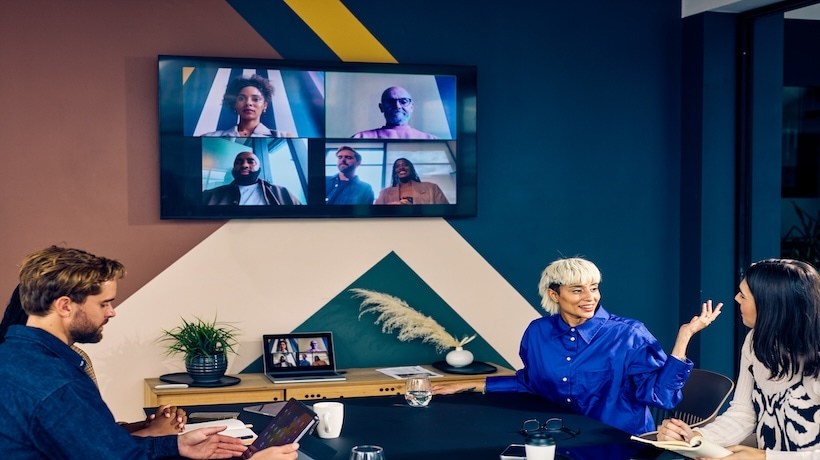Hybrid Learning Supports Hybrid Work
While the modus operandi of many organizations today is to navigate the transition of partial returns to the office, many employees still struggle to adjust to these changes, and the majority prefer working from home. According to research by the Pew Research Center, 61% of employees prefer working from home even though the office is open. As a result, organizations have been grappling with defining hybrid work guardrails and striking the right balance between employee engagement and productivity. A key element of employee engagement hinges on Learning and Development (L&D) growth opportunities. Employees who continue to work in hybrid environments also need relatable learning opportunities.
Over the past few years, organizations have been testing and piloting learning experiences using adaptive artificial intelligence (Adaptive AI) and Extended Reality (XR) capabilities such as Augmented and Virtual Reality. Leveraging such learning capabilities and exploring how to use them to complement in-person learning experiences has not been easy. As organizations continue to seek the right balance between in-person and online learning that resonates with their employee preferences, they will drive growth in this area. In this article, we explore what hybrid learning is, some of the benefits it offers, and seven steps to consider when building a hybrid learning experience: defining the learning goals, mapping the experience, deciding the live elements, delineating the online elements, running a pilot, iterating based on pilot results and launching.
What Is Hybrid Learning, And What Benefits Does It Offer?
Hybrid learning is a learning experience that provides the opportunity for students to join in person or online. Hybrid learning differs from blended learning, whereby some work is done online synchronously and some asynchronously. Key benefits of hybrid learning include flexibility for the learner because they can join from anywhere, efficiency for both instructors and learners because they can utilize the in-person time effectively, and time management because it forces the learner to manage their time and stay ahead of the curve.
Define The Learning Goals
Starting with the end result in mind is a great way to envision the business outcomes expected from this learning experience. Work backward to define the behavior changes expected from the learning experience, the learning activities, learning objectives, and learning goals that will get the learners to their destination.
Map The Learning Experience
Here, it is essential to use human-centered design tools so that you and your team put yourselves in the learner’s shoes. What does the experience look like from their perspective if they join remotely or in person? How will the remote and in-person learners connect? Mapping out the learning experience will require writing a script for how it will all play out: which elements will be addressed first, how the online synchronous part will evolve, and how the asynchronous feature will take place.
Decide On The Live Instruction Elements
This is critical because the learning experience will have to capitalize on the in-person time, whether live in the same physical room or live online. Some key activities to consider for the live instruction elements include small room discussions, one-on-one check-ins and feedback sessions, team presentations, and social interactions.
Delineate The Online Elements
The online elements are also critical because they allow the learner the freedom to be anywhere, anytime that works for them. Online features can include new information absorption, deep work, reflection, journaling, taking formative assessments, submitting work online, and engaging in a casual chat with the instructor. This is where you can incorporate Virtual Reality (VR) and Mixed Reality (MR) learning experiences using headsets and scenarios that resonate with your organizational business goals.
Run A Pilot
Pilots are a great way to test an idea because they are short in time span, low in risk, and high in lessons learned. A well-designed pilot can serve as a testing ground for your hybrid learning experience. Ensure that you have the right stakeholders and learners participating in the pilot so that you can gather valuable data points and insights from their varying experiences and vantage points. Pilots can be as short as a few days to a few weeks or a few months. A 90-day pilot usually allows L&D teams to plan, communicate, and run the pilot over 60-70 days and use the remaining 20-30 days to analyze the results and lessons learned as they prepare to iterate. A vital element of the pilot is testing the technology platforms and tools the instructors and the learners will be using in the hybrid environment.
Iterate
Pilot results are a gift you must leverage and use to iterate your hybrid learning experience. Review the qualitative and quantitative data you collected during the pilot. Which elements of the learning did the learners enjoy the most? Which elements did they hate? What recommendations did they make? How could you make the experience more engaging, less daunting, and more inviting? As you iterate, it is valuable to include learners on the team so that you have their perspectives and insights embedded in your effort. This can save time and money in the long run.
Launch
Once you pilot and iterate on your earlier version, you are now ready to launch your hybrid learning experience. Make sure to engage your communications team to launch an awareness campaign with web events, articles, and social media posts so that your learners get excited about the opportunity and look forward to experiencing it. Ensure that your L&D captures both qualitative and quantitative feedback through discussion and surveys so that you can continue the improvements as the hybrid learning experience matures.
Conclusion
To retain employees in hybrid working environments, organizations need to curate hybrid learning experiences to complement the hybrid work environment challenges. This article offers six steps to design a winning hybrid learning experience that centers on the learner and their needs and preferences, including defining the learning goals, mapping the experience, deciding the live elements, delineating the online elements, running a pilot, iterating based on pilot results, and launching the learning experience in your organization.









